当前位置:网站首页>Intel Distiller工具包-量化实现2
Intel Distiller工具包-量化实现2
2022-07-06 08:51:00 【cyz0202】
本系列文章
回顾
- 上一篇文章中介绍了Distiller及Quantizer基类,基类定义了重要的变量,如replacement_factory(dict,用于记录待量化module对应的wrapper);此外定义了量化流程,包括 预处理(BN折叠,激活优化等)、量化模块替换、后处理 等主要步骤;
- 本文介绍继承自Quantizer的子类量化器,包括
- PostTrainLinearQuantizer(本文)
- QuantAwareTrainRangeLinearQuantizer(后续)
- PACTQuantizer(后续)
- NCFQuantAwareTrainQuantizer(后续)
- 本文代码也挺多的,由于没法全部贴出来,有些地方说的不清楚的,还请读者去参考源码;
PostTrainLinearQuantizer
- 后训练量化器;对已训练好的模型进行量化,需要先使用少量输入收集模型内部输入、输出、权重的统计数据;
- PostTrainLinearQuantizer的类定义如下:主要内容在构造函数里,下面介绍;其他就是加了预处理(BN折叠、激活层优化)等;
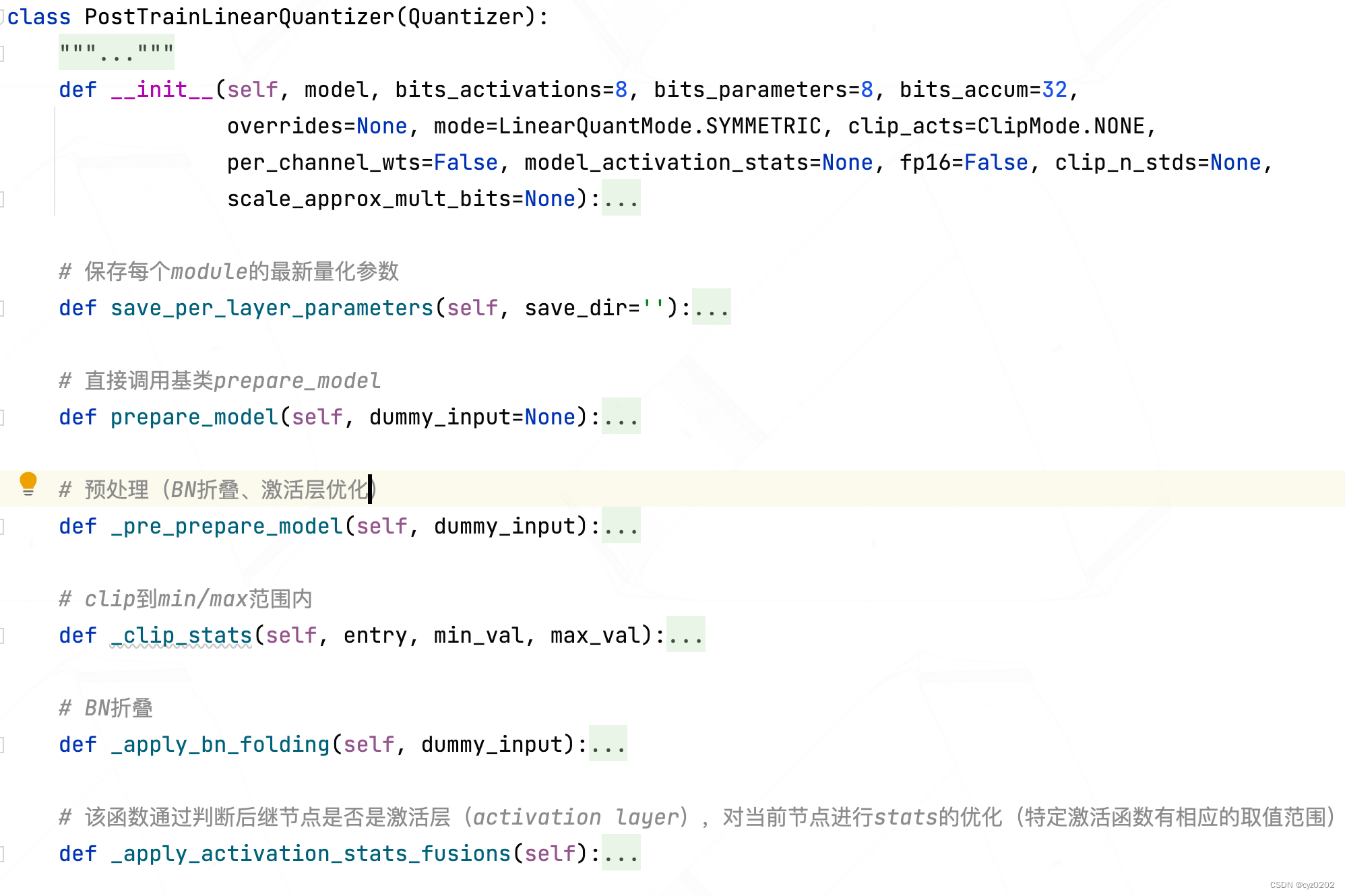
- 构造函数:重点在这
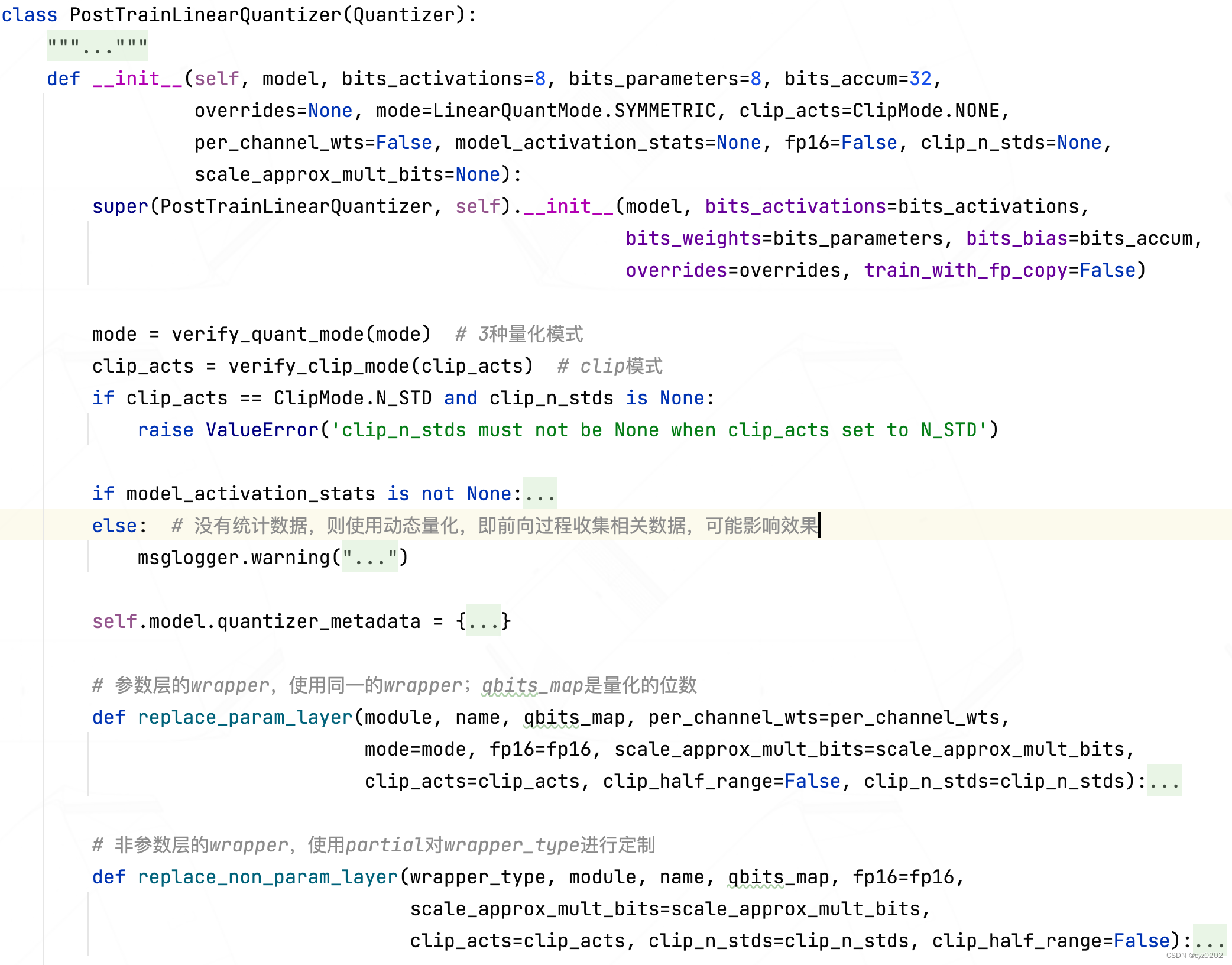
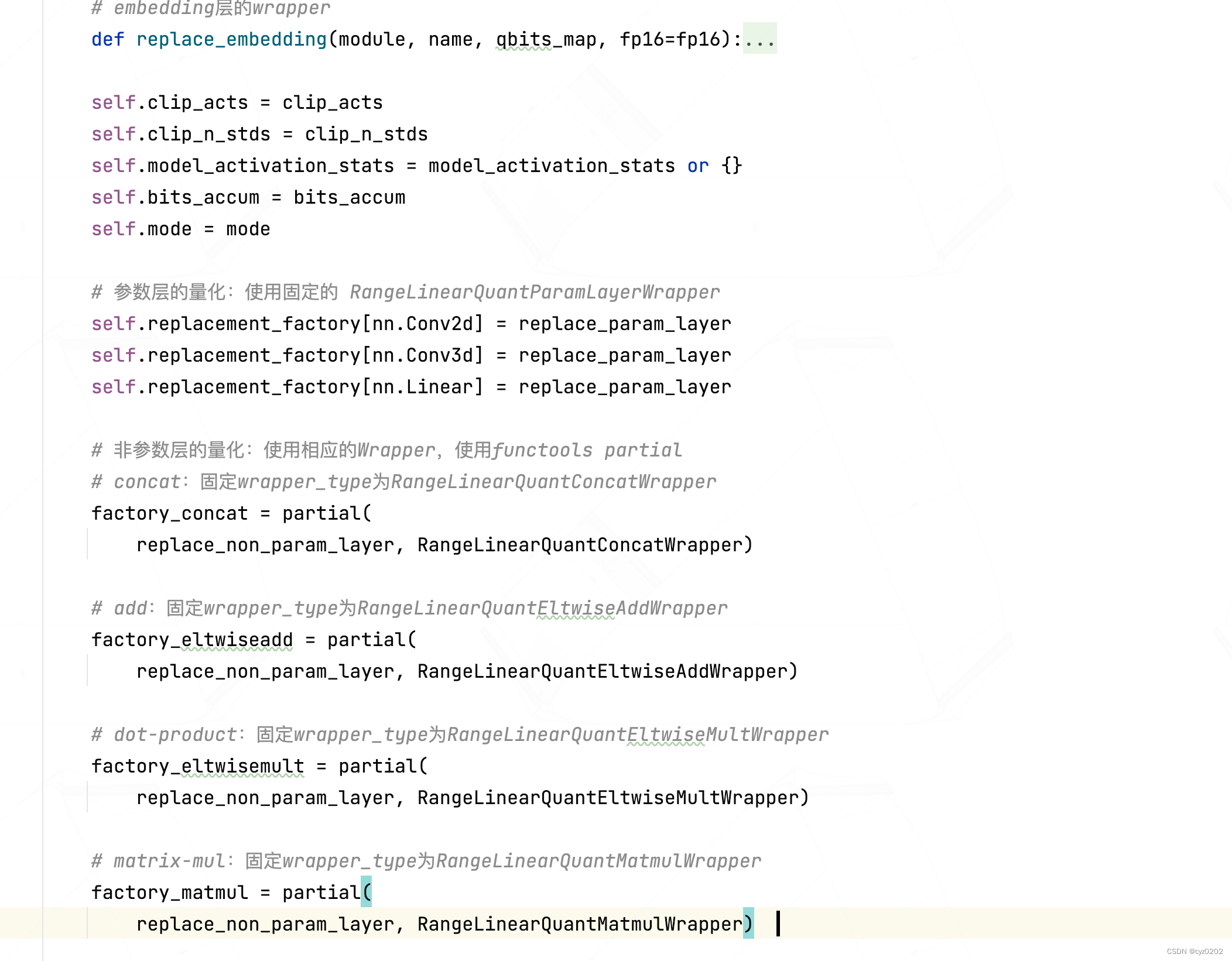
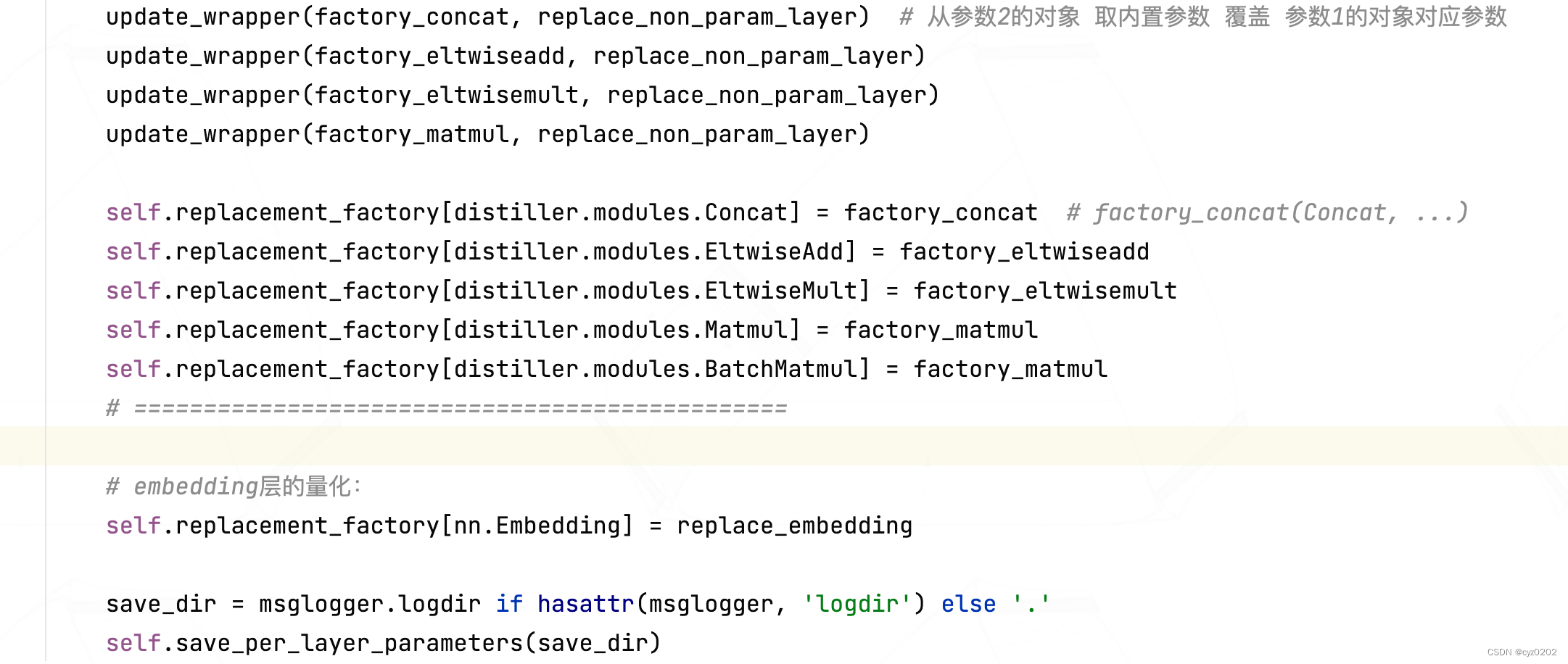
- 构造函数中,前面都是检查和默认设置(如量化模式检查、clip模式检查、是否有统计数据、默认量化设置等);直到下面这段代码,才是PostTrainLinearQuantizer核心
#### PART1-参数层的量化:使用固定的 RangeLinearQuantParamLayerWrapper #### self.replacement_factory[nn.Conv2d] = replace_param_layer self.replacement_factory[nn.Conv3d] = replace_param_layer self.replacement_factory[nn.Linear] = replace_param_layer #### PART2-非参数层的量化:使用相应的Wrapper,使用functools partial #### # concat:固定wrapper_type为RangeLinearQuantConcatWrapper factory_concat = partial( replace_non_param_layer, RangeLinearQuantConcatWrapper) # add:固定wrapper_type为RangeLinearQuantEltwiseAddWrapper factory_eltwiseadd = partial( replace_non_param_layer, RangeLinearQuantEltwiseAddWrapper) # dot-product:固定wrapper_type为RangeLinearQuantEltwiseMultWrapper factory_eltwisemult = partial( replace_non_param_layer, RangeLinearQuantEltwiseMultWrapper) # matrix-mul:固定wrapper_type为RangeLinearQuantMatmulWrapper factory_matmul = partial( replace_non_param_layer, RangeLinearQuantMatmulWrapper) update_wrapper(factory_concat, replace_non_param_layer) # 从参数2的对象 取内置参数 覆盖 参数1的对象对应参数 update_wrapper(factory_eltwiseadd, replace_non_param_layer) update_wrapper(factory_eltwisemult, replace_non_param_layer) update_wrapper(factory_matmul, replace_non_param_layer) self.replacement_factory[distiller.modules.Concat] = factory_concat # factory_concat(Concat, ...) self.replacement_factory[distiller.modules.EltwiseAdd] = factory_eltwiseadd self.replacement_factory[distiller.modules.EltwiseMult] = factory_eltwisemult self.replacement_factory[distiller.modules.Matmul] = factory_matmul self.replacement_factory[distiller.modules.BatchMatmul] = factory_matmul # =============================================== #### PART3-embedding层的量化:#### self.replacement_factory[nn.Embedding] = replace_embedding - 正如代码注释所述,代码分别对 可量化参数层、非参数层、embedding层进行量化设置
- 参数层:
- 以nn.Conv2d为例:self.replacement_factory[nn.Conv2d] = replace_param_layer
- 表示nn.Conv2d这个module会被replace_param_layer生成的量化版本module替换掉
- 我们来看看replace_param_layer是什么样的?
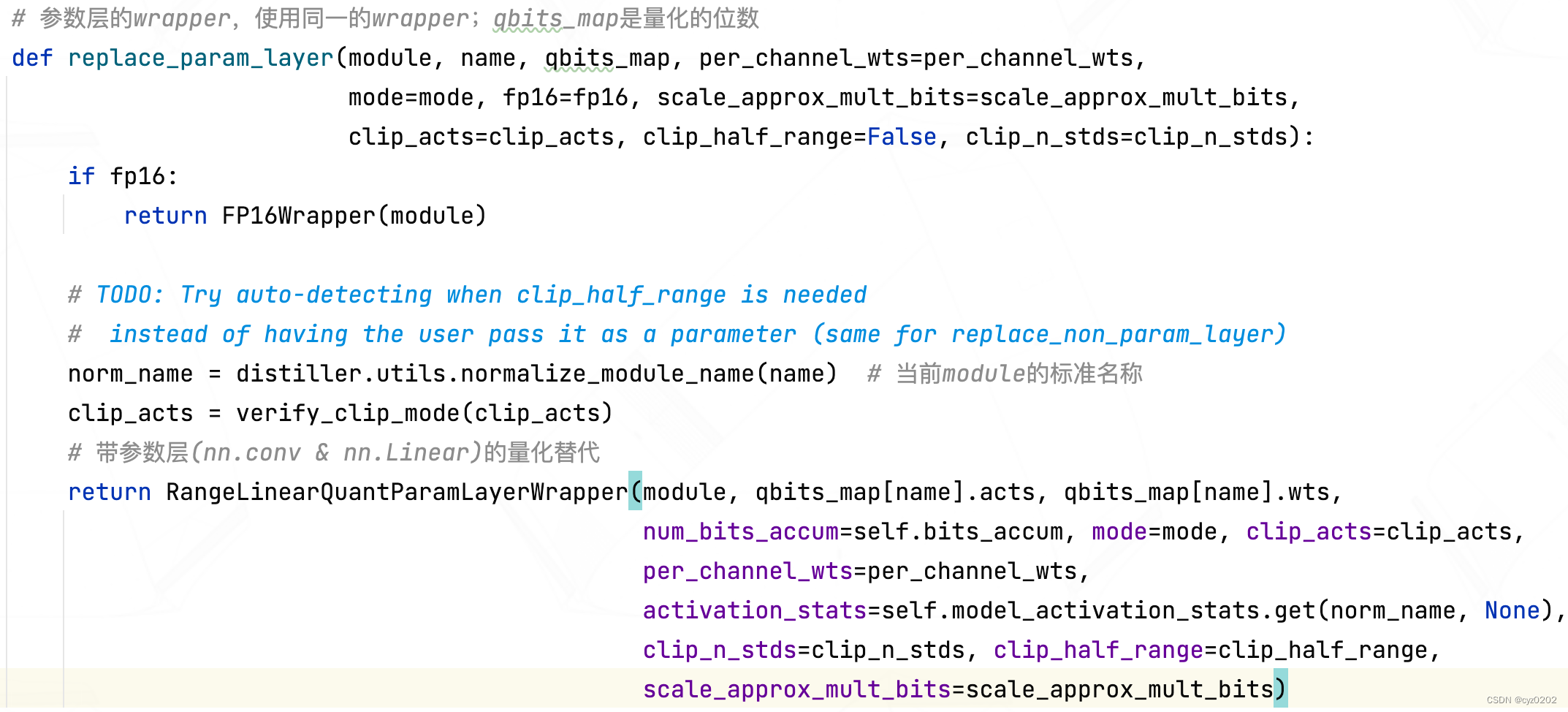
- 可以看到replace_param_layer在对module(此处指nn.Conv2d)封装时,其实返回的是RangeLinearQuantParamLayerWrapper对象(它是一个nn.Module,即新module替换旧module);所以我们再来看看这个wrapper对象是如何实现的;
- RangeLinearQuantParamLayerWrapper继承自RangeLinearQuantWrapper,需要先看看基类RangeLinearQuantWrapper的定义:
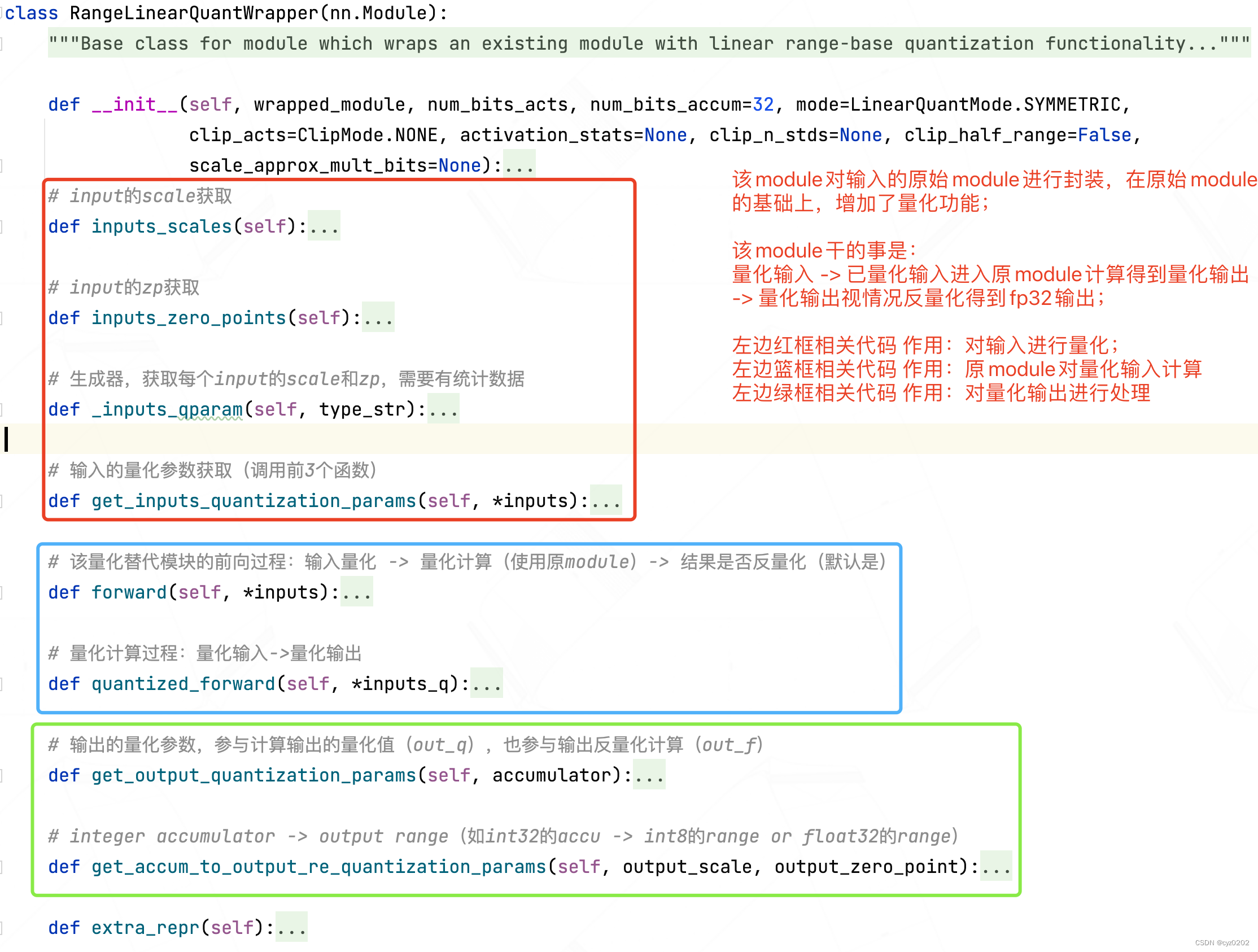
- 重点看一下forward函数:
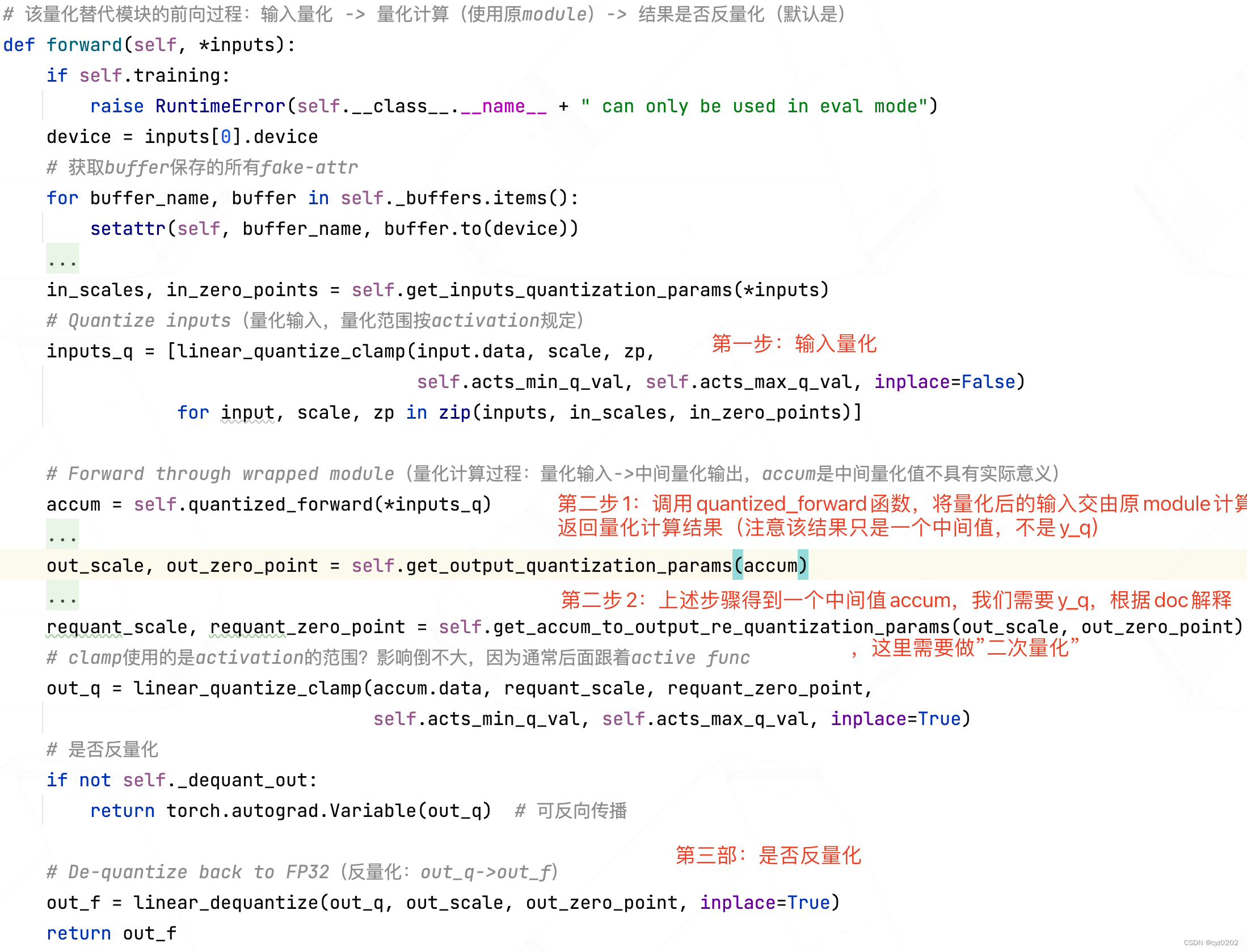
- RangeLinearQuantParamLayerWrapper需要根据基类RangeLinearQuantWrapper的定义和自身需求实现相关函数,主要是quantized_forward和get_accum_to_output_re_quantization_params;具体定义如下
# 定义了参数层量化的方式 class RangeLinearQuantParamLayerWrapper(RangeLinearQuantWrapper): """ Linear range-based quantization wrappers for layers with weights and bias (namely torch.nn.ConvNd and torch.nn.Linear) Assume: x_q = round(scale_x * x_f) - zero_point_x Hence: x_f = 1/scale_x * x_q + zero_point_x # 根据下面写法,应该是 1/scale_x * (x_q + zero_point_x) (And the same for y_q, w_q and b_q) So, we get: (use "zp" as abbreviation for zero_point) y_f = x_f * w_f + b_f # 以下除第一步外均省略round,注意中括号中,bias是作为re-quant-bias存在,也就是实现时是round()-0 y_q = round(scale_y * y_f) - zp_y = scale_y * (x_f * w_f + b_f) - zp_y = scale_y scale_x * scale_w = ------------------- * [(x_q + zp_x) * (w_q + zp_w) + ------------------- * (b_q + zp_b)] - zp_y scale_x * scale_w scale_b Args: wrapped_module (torch.nn.Module): Module to be wrapped num_bits_acts (int): Number of bits used for inputs and output quantization num_bits_params (int): Number of bits used for parameters (weights and bias) quantization num_bits_accum (int): Number of bits allocated for the accumulator of intermediate integer results mode (LinearQuantMode): Quantization mode to use (symmetric / asymmetric-signed/unsigned) clip_acts (ClipNode): See RangeLinearQuantWrapper per_channel_wts (bool): Enable quantization of weights using separate quantization parameters per output channel activation_stats (dict): See RangeLinearQuantWrapper clip_n_stds (int): See RangeLinearQuantWrapper clip_half_range (bool) : See RangeLinearQuantWrapper scale_approx_mult_bits (int): See RangeLinearQuantWrapper(是否使用整型处理scale) """ def __init__(self, wrapped_module, num_bits_acts, num_bits_params, num_bits_accum=32, mode=LinearQuantMode.SYMMETRIC, clip_acts=ClipMode.NONE, per_channel_wts=False, activation_stats=None, clip_n_stds=None, clip_half_range=False, scale_approx_mult_bits=None): super(RangeLinearQuantParamLayerWrapper, self).__init__(wrapped_module, num_bits_acts, num_bits_accum, mode, clip_acts, activation_stats, clip_n_stds, clip_half_range, scale_approx_mult_bits) if not isinstance(wrapped_module, (nn.Conv2d, nn.Conv3d, nn.Linear)): raise ValueError(self.__class__.__name__ + ' can wrap only Conv2D, Conv3D and Linear modules') self.num_bits_params = num_bits_params # 参数量化bits self.per_channel_wts = per_channel_wts # 权重是否逐通道量化 # 获取量化范围(根据量化模式)sign: [-128,127] unsign: [0, 255] self.params_min_q_val, self.params_max_q_val = get_quantized_range( num_bits_params, signed=mode != LinearQuantMode.ASYMMETRIC_UNSIGNED) # Quantize weights - overwrite FP32 weights(获取当前op权重weights的量化参数) w_scale, w_zero_point = _get_quant_params_from_tensor(wrapped_module.weight, num_bits_params, self.mode, per_channel=per_channel_wts) # 添加一个伪属性fake-attr,可保存但不参与参数更新 self.register_buffer('w_scale', w_scale) self.register_buffer('w_zero_point', w_zero_point) # 量化权重(weight.data)并且替换(inplace=True),注意要clamp(另一种方式是提前将x、w都clamp到规定的范围内) linear_quantize_clamp(wrapped_module.weight.data, self.w_scale, self.w_zero_point, self.params_min_q_val, self.params_max_q_val, inplace=True) self.has_bias = hasattr(wrapped_module, 'bias') and wrapped_module.bias is not None device = self.w_scale.device # 当前module是否有统计数据并且有input if self.preset_act_stats: self.in_0_scale = self.in_0_scale.to(device) # 只使用第一个input的scale self.register_buffer('accum_scale', self.in_0_scale * self.w_scale) if self.per_channel_wts: # TODO how? self.accum_scale = self.accum_scale.squeeze(dim=-1) else: self.accum_scale = 1 # Quantize bias self.has_bias = hasattr(wrapped_module, 'bias') and wrapped_module.bias is not None if self.has_bias: if self.preset_act_stats: # 如果accu_scale可以根据统计数据得到,则令bias_scale==accu_scale,bias_zp==0,量化范围也来自accu # 注意这里的量化方式,是根据doc里的公式设计的;此外,bias根据accum的量化范围进行clamp linear_quantize_clamp(wrapped_module.bias.data, self.accum_scale.squeeze(), 0, self.accum_min_q_val, self.accum_max_q_val, inplace=True) else: # 否则使用bias自己的scale和zp和通用量化范围 b_scale, b_zero_point = _get_quant_params_from_tensor(wrapped_module.bias, num_bits_params, self.mode) self.register_buffer('b_scale', b_scale) self.register_buffer('b_zero_point', b_zero_point) # TODO 注意inplace=False,dynamic requantize,why? base_b_q = linear_quantize_clamp(wrapped_module.bias.data, self.b_scale, self.b_zero_point, self.params_min_q_val, self.params_max_q_val) # Dynamic ranges - save in auxiliary buffer, requantize each time based on dynamic input scale factor self.register_buffer('base_b_q', base_b_q) # A flag indicating that the simulated quantized weights are pre-shifted. for faster performance. # In the first forward pass - `w_zero_point` is added into the weights, to allow faster inference, # and all subsequent calls are done with these shifted weights. # Upon calling `self.state_dict()` - we restore the actual quantized weights. # i.e. is_simulated_quant_weight_shifted = False self.register_buffer('is_simulated_quant_weight_shifted', torch.tensor(0, dtype=torch.uint8, device=device)) def state_dict(self, destination=None, prefix='', keep_vars=False): if self.is_simulated_quant_weight_shifted: # We want to return the weights to their integer representation: # 根据doc,weight要加上w_zp,利用is_simulated_quant_weight_shifted标记;保存的时候恢复到真实的weight self.wrapped_module.weight.data -= self.w_zero_point self.is_simulated_quant_weight_shifted.sub_(1) # i.e. is_simulated_quant_weight_shifted = False return super(RangeLinearQuantParamLayerWrapper, self).state_dict(destination, prefix, keep_vars) def get_inputs_quantization_params(self, input): if not self.preset_act_stats: # 如果没有统计数据提供支持,则需要dynamic计算 self.in_0_scale, self.in_0_zero_point = _get_quant_params_from_tensor( input, self.num_bits_acts, self.mode, clip=self.clip_acts, num_stds=self.clip_n_stds, scale_approx_mult_bits=self.scale_approx_mult_bits) return [self.in_0_scale], [self.in_0_zero_point] def quantized_forward(self, input_q): # See class documentation for quantized calculation details. if not self.preset_act_stats: # 没有统计数据 # 基类中 self.accum_scale = 1,这里重置 self.accum_scale = self.in_0_scale * self.w_scale # in_0_scale在get_inputs_quantization_params中补全定义了 if self.per_channel_wts: self.accum_scale = self.accum_scale.squeeze(dim=-1) if self.has_bias: # Re-quantize bias to match x * w scale: # b_q' = (in_scale * w_scale / b_scale) * (b_q + b_zero_point) bias_requant_scale = self.accum_scale.squeeze() / self.b_scale if self.scale_approx_mult_bits is not None: bias_requant_scale = approx_scale_as_mult_and_shift(bias_requant_scale, self.scale_approx_mult_bits) # 没有统计数据情况下,对bias根据accum scale进行*重新*量化(根据doc里的公式,但公式里原来是没有round的) # b_q' = round[(in_scale * w_scale / b_scale) * (base_b_q + b_zero_point)] - 0 self.wrapped_module.bias.data = linear_quantize_clamp(self.base_b_q + self.b_zero_point, bias_requant_scale, 0, self.accum_min_q_val, self.accum_max_q_val) # Note the main terms within the summation is: # (x_q + zp_x) * (w_q + zp_w) # In a performance-optimized solution, we would expand the parentheses and perform the computation similar # to what is described here: # https://github.com/google/gemmlowp/blob/master/doc/low-precision.md#efficient-handling-of-offsets # However, for now we're more concerned with simplicity rather than speed. So we'll just add the zero points # to the input and weights and pass those to the wrapped model. Functionally, since at this point we're # dealing solely with integer values, the results are the same either way. if self.mode != LinearQuantMode.SYMMETRIC and not self.is_simulated_quant_weight_shifted: # We "store" the w_zero_point inside our wrapped module's weights to # improve performance on inference. self.wrapped_module.weight.data += self.w_zero_point # 对称模式w_zp=0 self.is_simulated_quant_weight_shifted.add_(1) # i.e. is_simulated_quant_weight_shifted = True input_q += self.in_0_zero_point # 执行doc中的 (x_q + zp_x) * (w_q + zp_w) + # round[ (in_scale * w_scale / b_scale) * (b_q + b_zero_point) - 0 ] # 获得accum,注意只是个中间量化值,没有实际意义 accum = self.wrapped_module.forward(input_q) # accum的量化范围是32bits clamp(accum.data, self.accum_min_q_val, self.accum_max_q_val, inplace=True) return accum def get_output_quantization_params(self, accumulator): if self.preset_act_stats: return self.output_scale, self.output_zero_point # TODO why? 没有历史统计数据的话,scale_y和zp_y都无从获得? y_f = accumulator / self.accum_scale return _get_quant_params_from_tensor(y_f, self.num_bits_acts, self.mode, clip=self.clip_acts, num_stds=self.clip_n_stds, scale_approx_mult_bits=self.scale_approx_mult_bits) def get_accum_to_output_re_quantization_params(self, output_scale, output_zero_point): requant_scale = output_scale / self.accum_scale if self.scale_approx_mult_bits is not None: requant_scale = approx_scale_as_mult_and_shift(requant_scale, self.scale_approx_mult_bits) return requant_scale, output_zero_point - 整体思路是:
- 在doc里,解释了distiller是如何将原计算转换成 float -> int -> float形式的 ,并让原module执行int部分的计算,达到核心计算由int执行的目的(即实现量化计算)
- __init__中,事先计算weight、bias(如果有)的量化值;此处根据是否有统计数据会有些处理上的差异;
- quantized_forward函数:接收量化的输入,然后让原module执行量化计算,返回的是中间量化值(不是y_f对应的y_q)
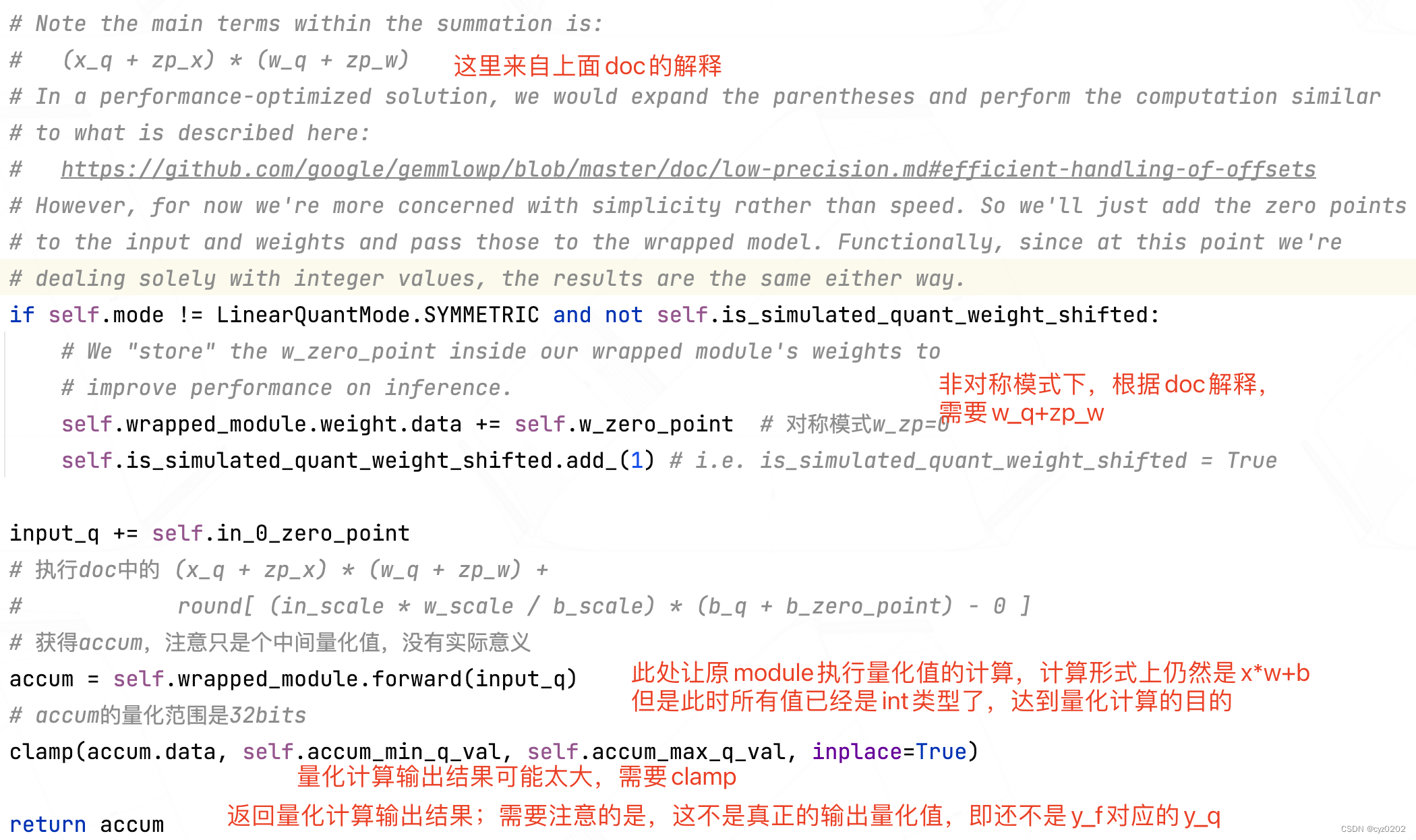
get_accum_to_output_re_quantization_params函数:根据doc解释,要得到最终的量化输出结果y_q,还需要对quantized_forward的输出值(accum)进行变换;观察doc解释,该变换又可以视为一种量化,因此该函数根据doc输出 二次量化的scale和zp;
小结:
通过上述module替换(封装),当做inference时,虽然nn.Conv2d不变,但是计算时就变成int类型计算了;
值得一提的是,distiller工具包没有实现整型的gemm(矩阵乘/igemm),因此量化后还需要引入igemm包;
- 非参数层
- 非参数层和参数层做法大体类似,只不过因为没有参数,所以有些不同
- 举例说明:这是对加法操作(distiller现将其封装为module)进行的量化
# add:固定wrapper_type为RangeLinearQuantEltwiseAddWrapper factory_eltwiseadd = partial(replace_non_param_layer, RangeLinearQuantEltwiseAddWrapper) - replace_non_param_layer类似replace_param_layer,但是多了一个参数wrapper_type,表示wrapper类型;该参数的设置是为了复用函数考虑的,因为非参module较多(如加法、逐元素乘法/点积、批乘法等),各个module需要使用不同的wrapper;定义如下:
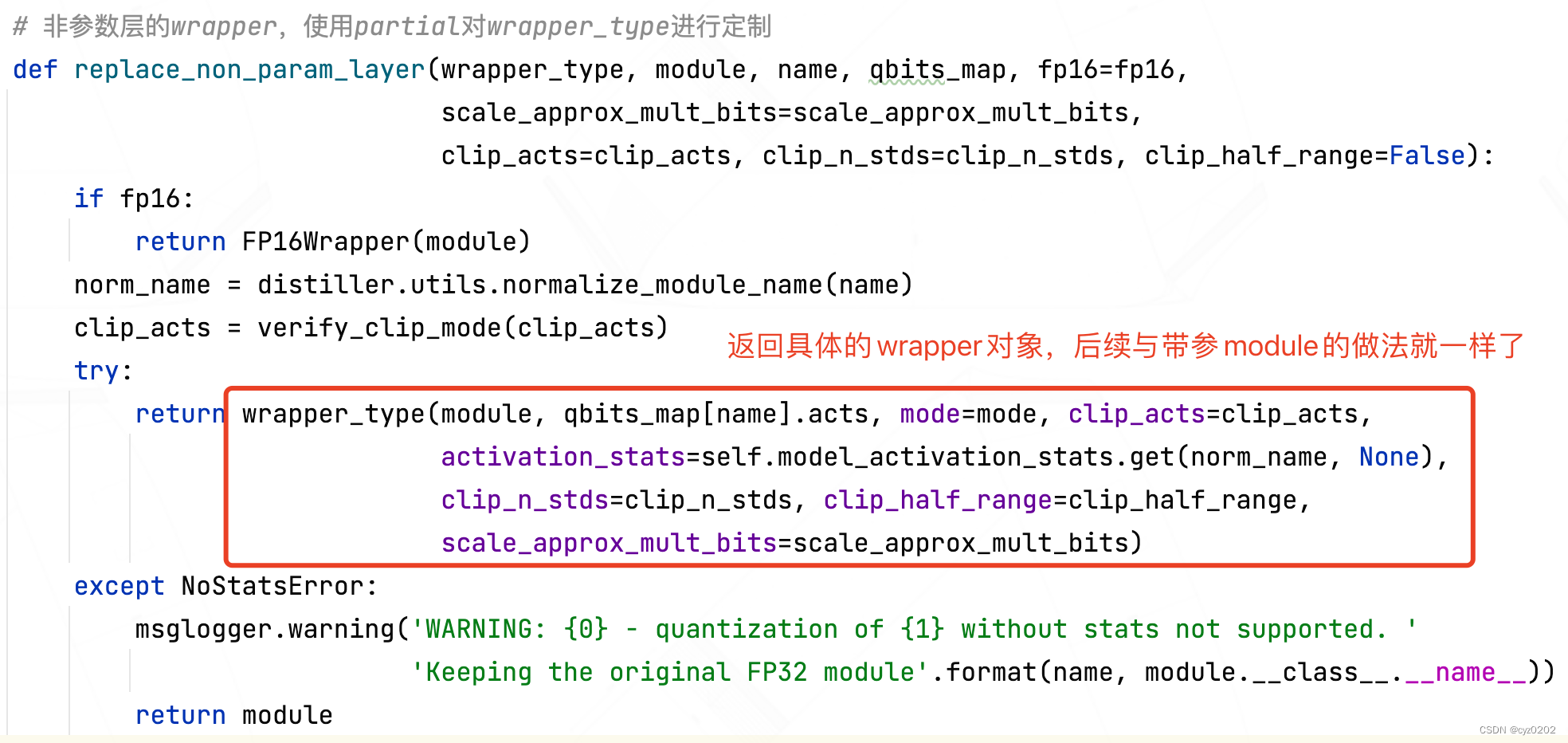
- 看一下eltwiseadd的wrapper,实现思路和上面的带参wrapper是一样的,不一样的是quantized_forward代表的量化实现过程
class RangeLinearQuantEltwiseAddWrapper(RangeLinearQuantWrapper): """ add-0107-zyc y_f = in0_f + in1_f in0_q = round(in0_f * scale_in0) - zp_in0 in1_q = round(in1_f * scale_in1) - zp_in1 y_q = round(y_f * scale_y) - zp_y => 以下省略round = scale_y * ( in0_f + in1_f ) - zp_y scale_y = ------------------- * [ scale_in1*(in0_q + zp_in0) + (in1_q + zp_in1)*scale_in0 ] - zp_y scale_in0*scale_in1 => 可以发现上式不能进行int计算,所以需要进一步处理:对in0_q和in1_q重新量化,scale统一为该节点output/accum的scale in0_re_q = scale_accum * [( in0_q + zp_in0 ) / scale_in0] - 0 # 此时新的scale为scale_accum,zp为0 in1_re_q = scale_accum * [( in0_q + zp_in1 ) / scale_in1] - 0 => 则 y_q = round(y_f * scale_y) - zp_y => 以下省略round = scale_y * ( in0_f + in1_f ) - zp_y scale_y = ------------------------- * [scale_re_in1*(in0_re_q+zp_re_in0)+(in1_re_q+zp_re_in1)*scale_re_in0] - zp_y scale_re_in0*scale_re_in1 = 1 * [ (in0_re_q + zp_re_in0) + (in1_re_q + zp_re_in1) ] - zp_y = 1 * (in0_re_q + in1_re_q) - zp_y note:从推导的角度来看,上述重量化做法并没有问题 """ def __init__(self, wrapped_module, num_bits_acts, mode=LinearQuantMode.SYMMETRIC, clip_acts=ClipMode.NONE, activation_stats=None, clip_n_stds=None, clip_half_range=False, scale_approx_mult_bits=None): if not isinstance(wrapped_module, distiller.modules.EltwiseAdd): raise ValueError(self.__class__.__name__ + ' can only wrap distiller.modules.EltwiseAdd modules') if not activation_stats: raise NoStatsError(self.__class__.__name__ + ' must get activation stats, dynamic quantization not supported') super(RangeLinearQuantEltwiseAddWrapper, self).__init__(wrapped_module, num_bits_acts, mode=mode, clip_acts=clip_acts, activation_stats=activation_stats, clip_n_stds=clip_n_stds, clip_half_range=clip_half_range, scale_approx_mult_bits=scale_approx_mult_bits) if self.preset_act_stats: # For addition to make sense, all input scales must match. So we set a re-scale factor according # to the preset output scale requant_scales = [self.output_scale / in_scale for in_scale in self.inputs_scales()] if scale_approx_mult_bits is not None: requant_scales = [approx_scale_as_mult_and_shift(requant_scale, scale_approx_mult_bits) for requant_scale in requant_scales] for idx, requant_scale in enumerate(requant_scales): self.register_buffer('in_{0}_requant_scale'.format(idx), requant_scale) def inputs_requant_scales(self): if not self.preset_act_stats: raise RuntimeError('Input quantization parameter iterators only available when activation stats were given') for idx in range(self.num_inputs): name = 'in_{0}_requant_scale'.format(idx) yield getattr(self, name) def get_inputs_quantization_params(self, *inputs): return self.inputs_scales(), self.inputs_zero_points() def quantized_forward(self, *inputs_q): # Re-scale inputs to the accumulator range # 对已量化的输入重新量化,scale变为accum的(self.output_scale),如此统一了scale_in inputs_re_q = [linear_quantize_clamp(input_q + zp, requant_scale, 0, self.accum_min_q_val, self.accum_max_q_val, inplace=False) for input_q, requant_scale, zp in zip(inputs_q, self.inputs_requant_scales(), self.inputs_zero_points())] accum = self.wrapped_module(*inputs_re_q) clamp(accum.data, self.accum_min_q_val, self.accum_max_q_val, inplace=True) return accum def get_output_quantization_params(self, accumulator): return self.output_scale, self.output_zero_point def get_accum_to_output_re_quantization_params(self, output_scale, output_zero_point): return 1., self.output_zero_point
- Embedding层
- 该层的量化计算就比较简单了(其实不做量化也行吧,除非为了减少模型大小),以下为定义:
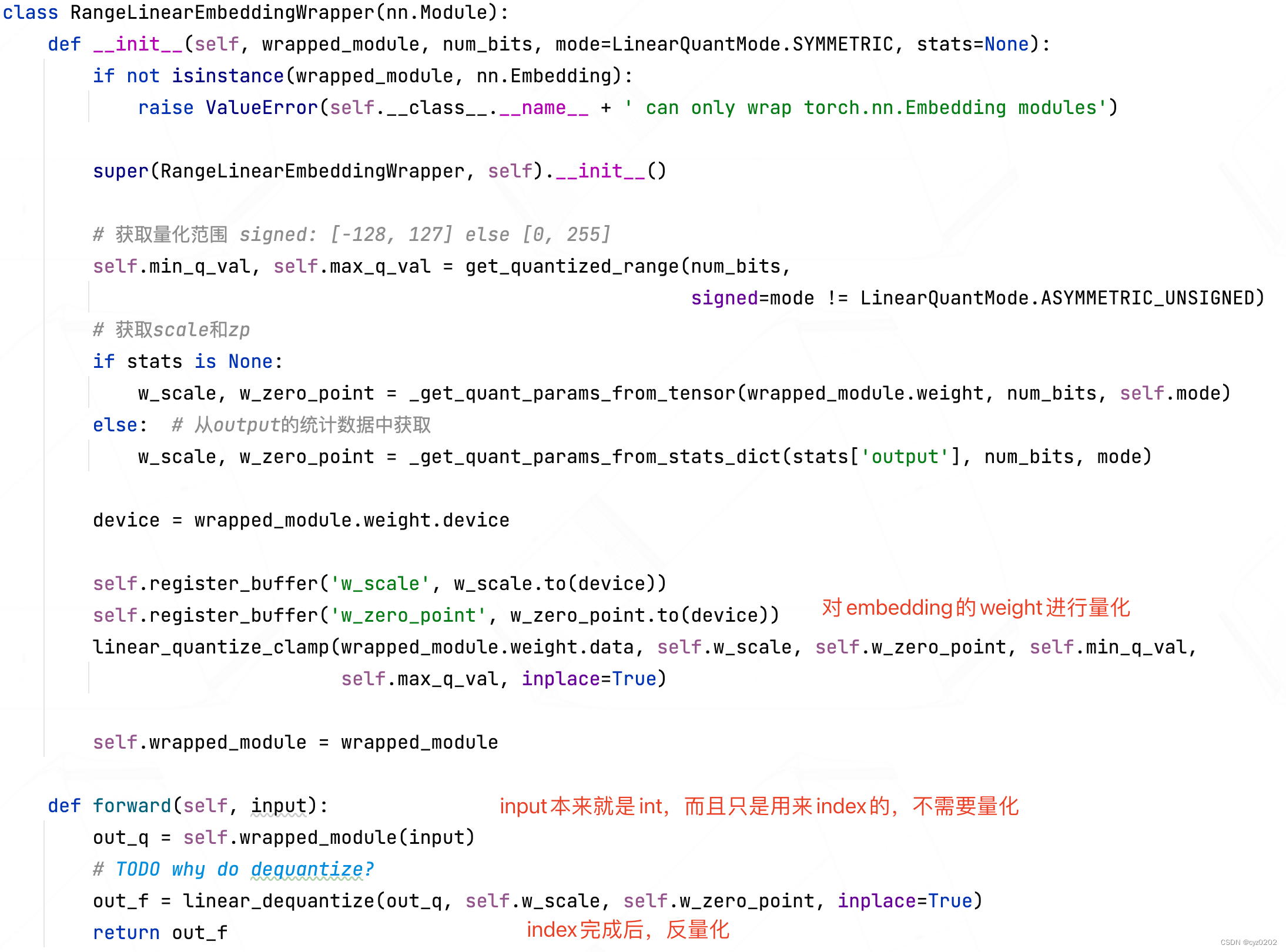
- 可以看到,没有复杂的quantized_forward和二次量化;
- 该层的量化计算就比较简单了(其实不做量化也行吧,除非为了减少模型大小),以下为定义:
- 小结:以上介绍了后训练量化器是如何实现的,核心部分是 各类wrapper 对原module的封装替代;
- 补充:scale(一般是float)的整型计算方法
- 直接上代码了;基本思想就是 floor(scale*2^N) / (2^N),N其实能大就大
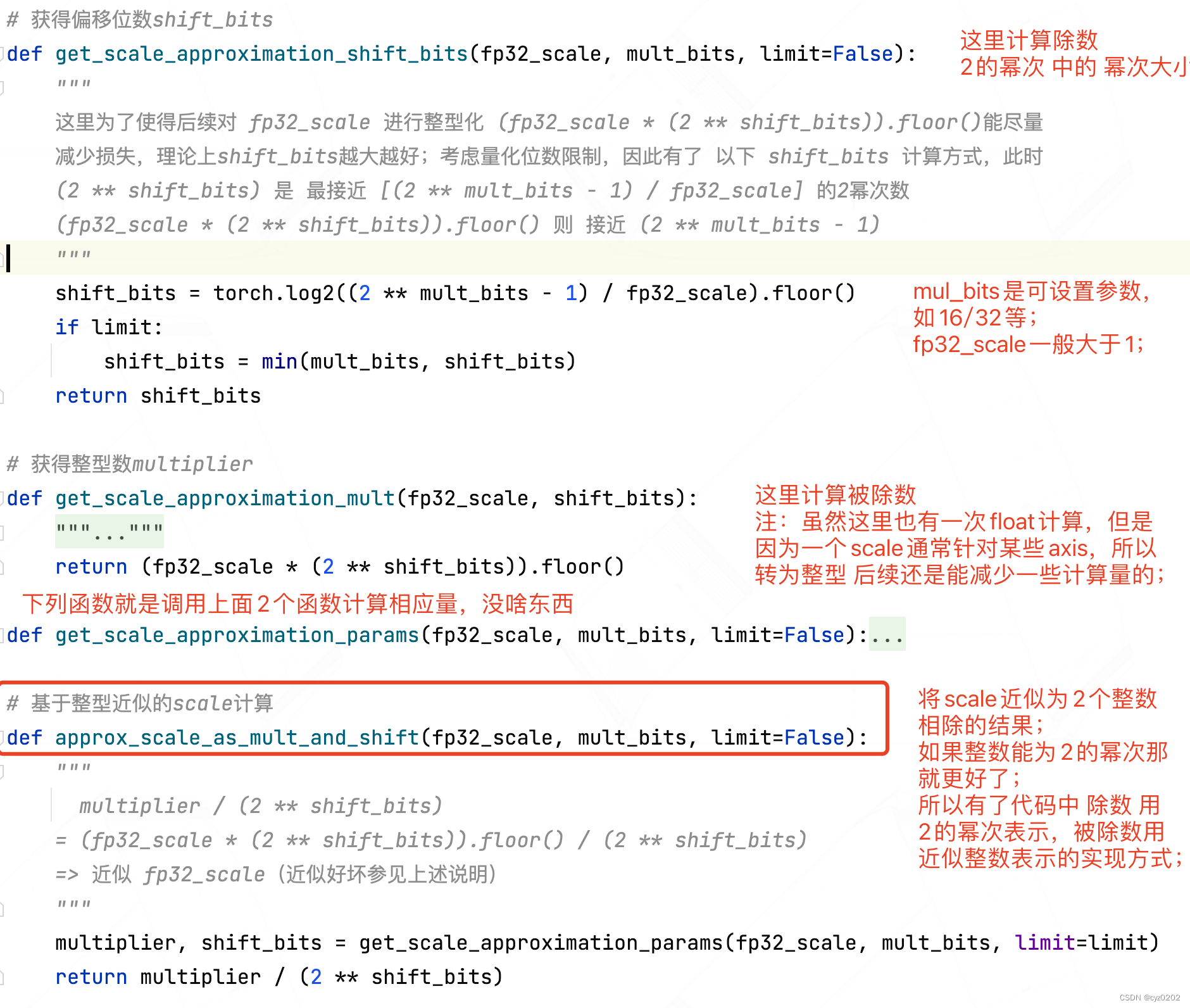
- 直接上代码了;基本思想就是 floor(scale*2^N) / (2^N),N其实能大就大
- 参数层:
- BN折叠实现
- 见BN折叠
- 激活层优化
- 待补充
总结
- 本文介绍了distiller量化器基类Quantizer的一个子类:PostTrainLinearQuantizer;
- 核心部分是 各类wrapper 对原module的封装替代;以及一些优化处理,如BN折叠、激活层优化、scale整型化计算等;
边栏推荐
- 企微服务商平台收费接口对接教程
- Excellent software testers have these abilities
- LeetCode:236. 二叉树的最近公共祖先
- Niuke winter vacation training 6 maze 2
- Tdengine biweekly selection of community issues | phase III
- 【嵌入式】Cortex M4F DSP库
- Delay initialization and sealing classes
- The harm of game unpacking and the importance of resource encryption
- JVM quick start
- UnsupportedOperationException异常
猜你喜欢
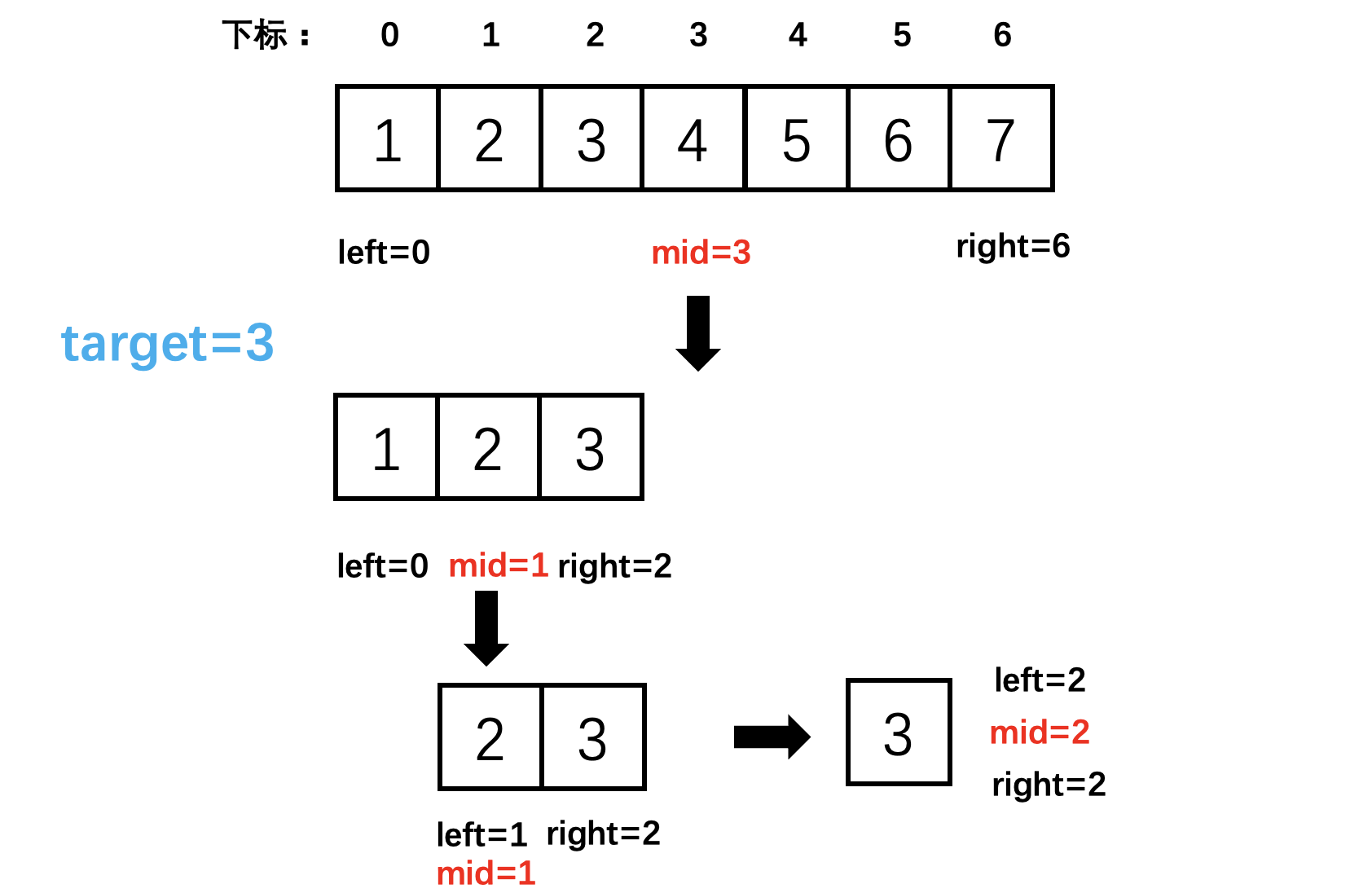
704 binary search
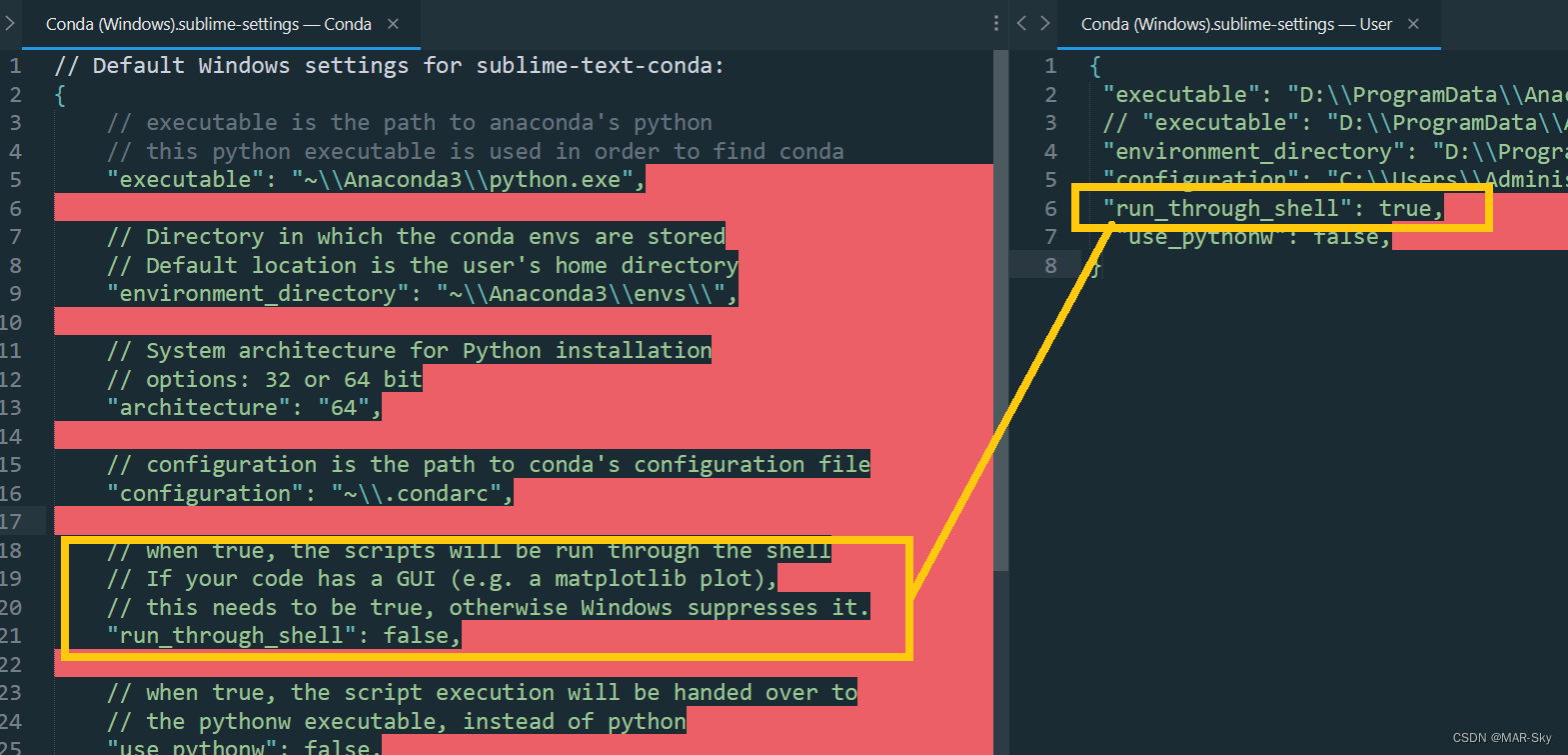
Sublime text in CONDA environment plt Show cannot pop up the problem of displaying pictures
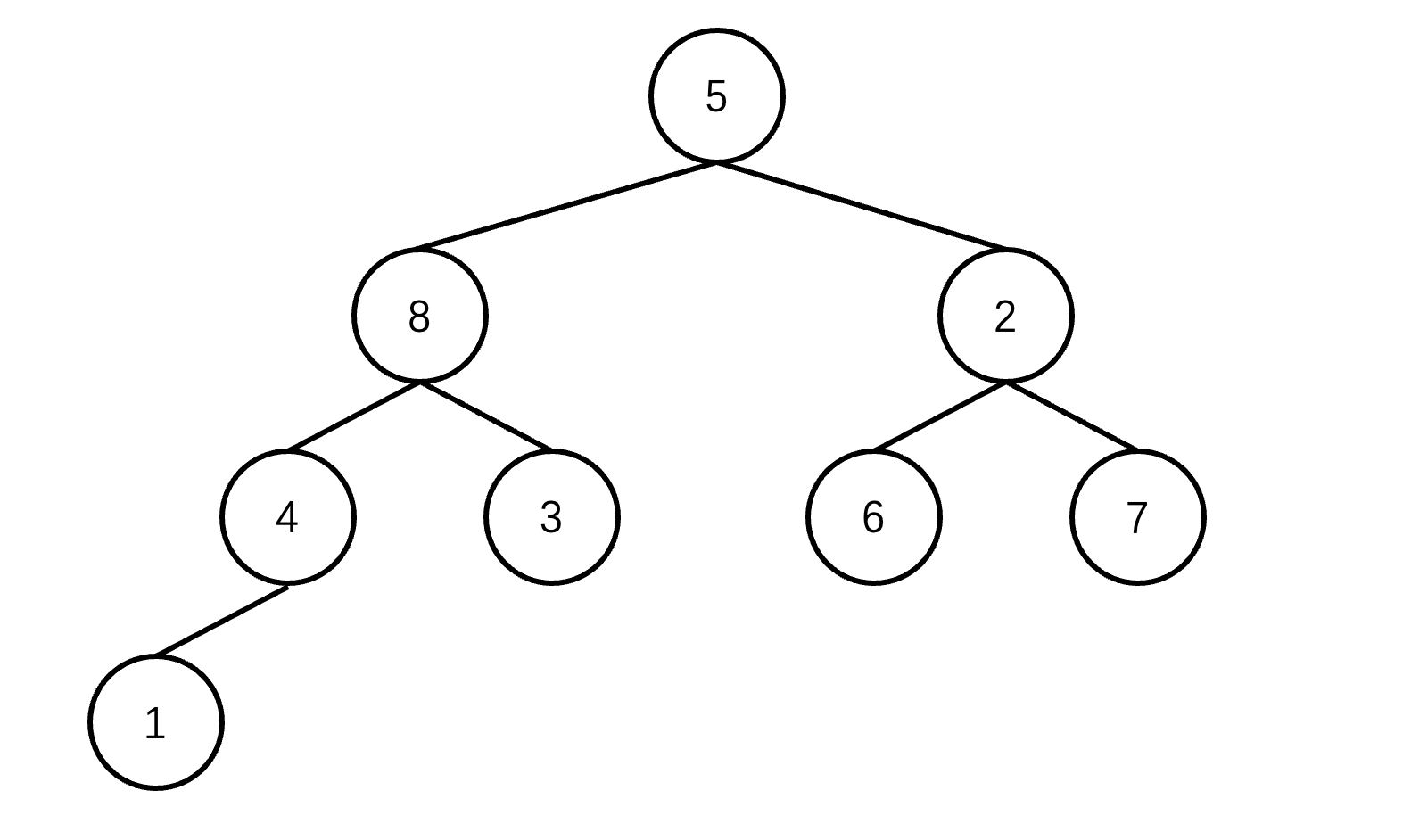
Detailed explanation of heap sorting
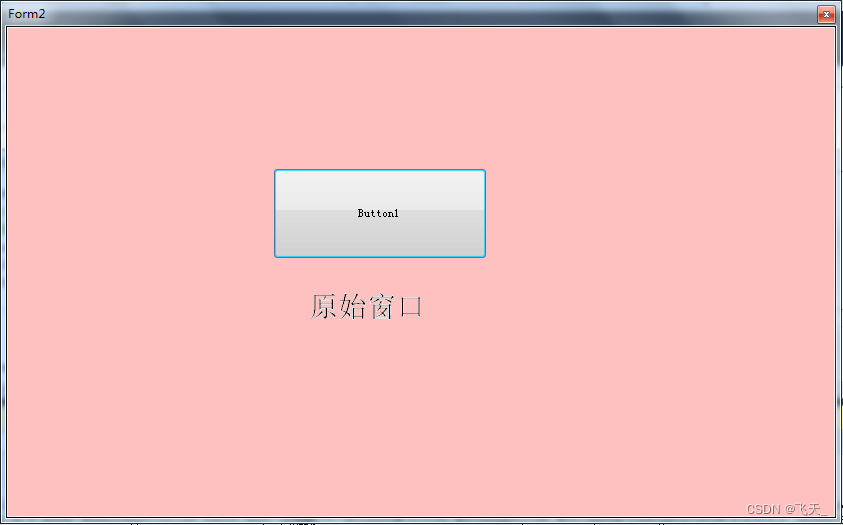
vb. Net changes with the window, scales the size of the control and maintains its relative position
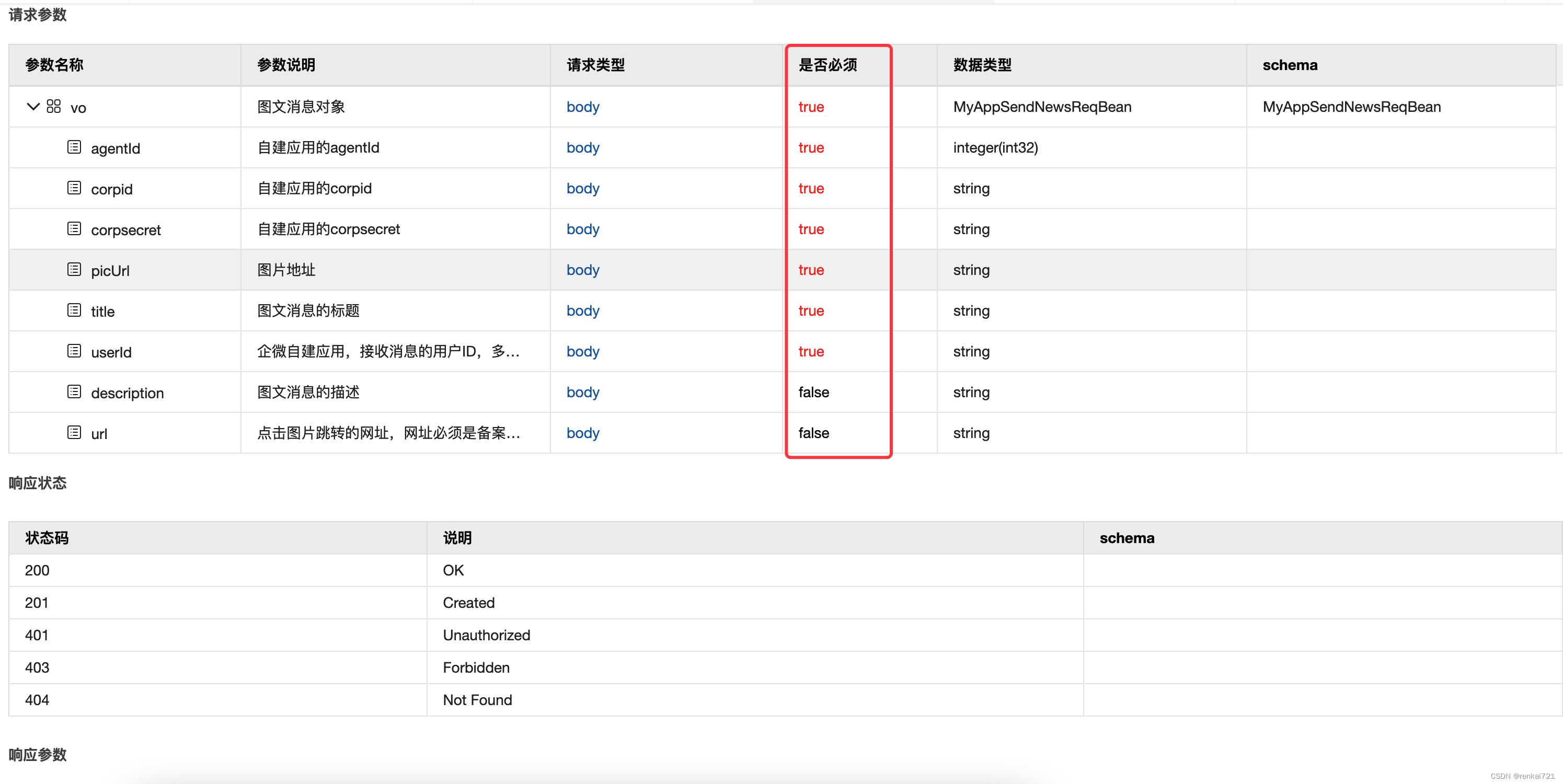
Swagger setting field required is mandatory
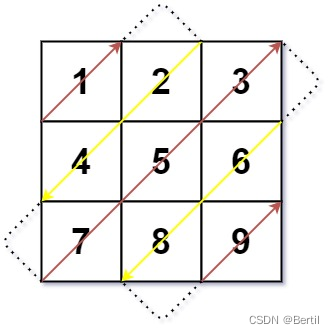
LeetCode:498. Diagonal traversal
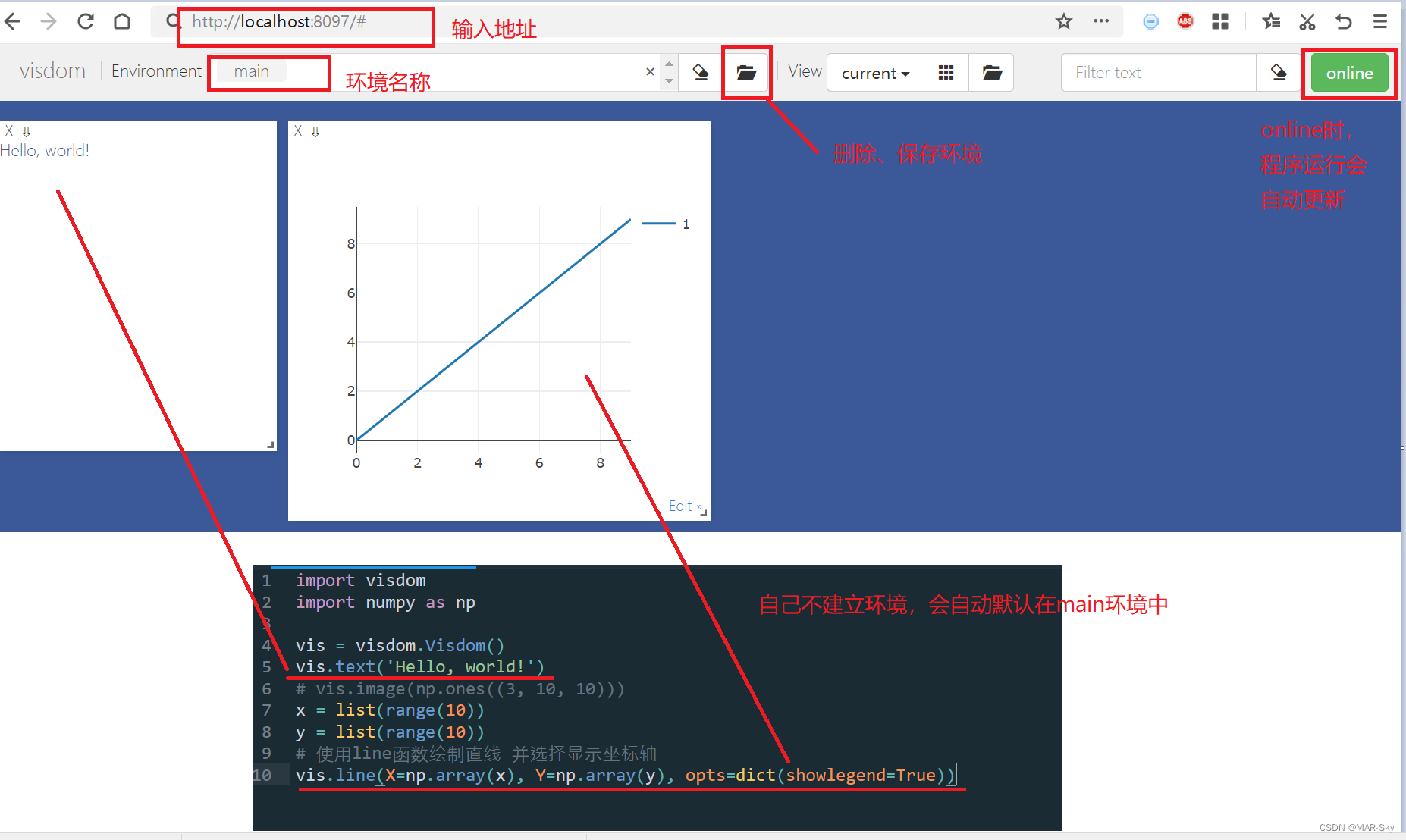
visdom可视化实现与检查介绍

Deep analysis of C language pointer
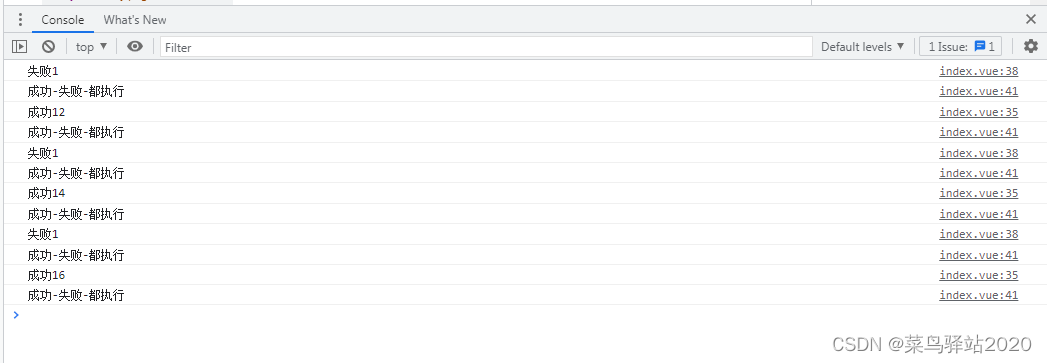
Simple use of promise in uniapp

使用latex导出IEEE文献格式
随机推荐
PC easy to use essential software (used)
LeetCode:498. Diagonal traversal
Navicat Premium 创建MySql 创建存储过程
多元聚类分析
广州推进儿童友好城市建设,将探索学校周边200米设安全区域
MySQL uninstallation and installation methods
Leetcode刷题题解2.1.1
TDengine 社区问题双周精选 | 第三期
Mobile phones and computers on the same LAN access each other, IIS settings
LeetCode:41. 缺失的第一个正数
To effectively improve the quality of software products, find a third-party software evaluation organization
查看局域网中电脑设备
CSP first week of question brushing
Swagger setting field required is mandatory
Computer cleaning, deleted system files
Leetcode: Sword Finger offer 42. Somme maximale des sous - tableaux consécutifs
Hutool gracefully parses URL links and obtains parameters
LeetCode:34. 在排序数组中查找元素的第一个和最后一个位置
704 binary search
Tcp/ip protocol